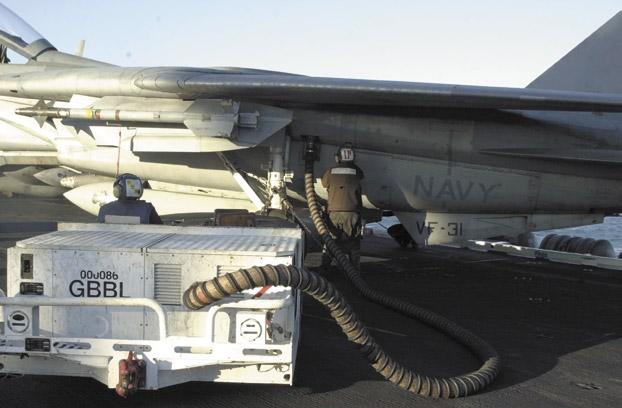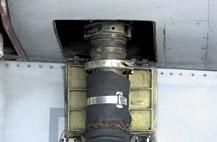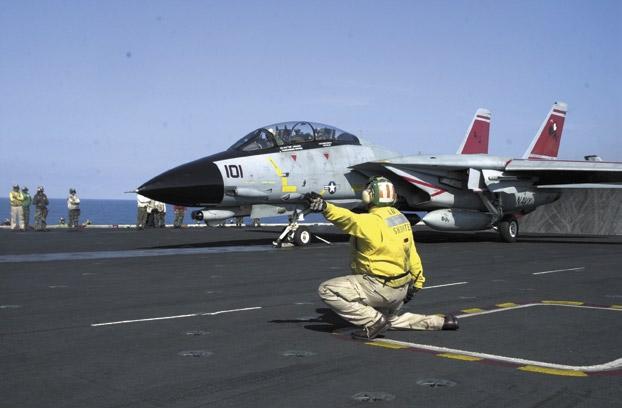
4 minute read
ORM: Assess the Environment and Dodge the Huffer Hose
By Lt. John Turner
VF-31 completed another compressed interthing home safely and in one piece. Reflecting back on deployment readiness cycle (IDRC), logging my tour from that viewpoint, I maintain that we were more than 3,200 hours in the 10-months since extremely successful. Still, accidents happened. our last deployment. Then we deployed to the Arabian I remember the call, “Medical emergency! MediGulf, conducting combat operations in support of the cal emergency! Medical emergency on the flight deck.” Global War on Terror. We accomplished this feat safely. The announcement rang across the 1-MC. During F-14 I am proud of both the squadron’s achievement and my startup and hydraulic zero-air procedures, a start unit’s maintainers’ accomplishments, despite having suffered pneumatic-starter duct (huffer hose), charged at 75 psi, bumps and bruises during the cruise. Along the way, I had separated from the aircraft quick-disconnect coulearned a lesson about the need to answer the “what pling. The wild hose struck my plane captain (PC) on ifs” before doing any task. the back, bringing him to the deck. After initial numb
Advertisement
My philosophy on success in the business of warness and tremendous anxiety, he began to move his fighting remains unchanged: Bring everyone and everyextremities, placing my mind at ease.

The wild hose struck my plane captain (PC) on the back, bringing him to the deck.

These bands hold the hose to the coupler and often become damaged or aren’t connected properly. It’s critical to attach the hose securely to a coupler like this one.
Take a look at the hose and bands for wear and security.

Over the years, innovations in material composition and improved maintenance procedures have reduced the frequency of material failure. Yet, the hazard still exists. Can any hazard be completely eliminated?
On board ship or station, squadron ground crews and hangar or flight-deck personnel inspect assigned support equipment (SE) daily. The NAVAIR 19-600- 306-6-1 checklist specifies, “Visually inspect pneumatic duct for evidence of damage (chafing and tears), connectors for integrity of banding material, air-hose coupling (aircraft side) for integrity of safety wire, and quick-disconnect coupling-retaining mechanism for corrosion and for presence of retaining balls.” In this
A hose can fl ail around once it separates from a coupler.
incident, the inspection had been performed, and no indications of impending material failure were discovered. Nevertheless, the hose-fixture union failed. The effects of the failure could have been far more devastating had my PC not employed effective operational risk management (ORM).
Effective ORM has five steps: Identify the hazard, assess the hazard, make risk decisions, implement controls, and supervise. Applying sound ORM principles cannot eliminate every risk or avert damage to equipment and injury to personnel, but I submit that adherence to its principles will limit the negative impacts of those risks.
VF-31 aircraft on the flight deck ready for a cat shot.

Naval aviation is inherently dangerous. We require constant reminders of its hazards. By possessing a keen awareness of our operating environment (“head on a swivel,” as my father always said) and understanding the risks, we can predict, with a degree of certainty, the answers to the “what ifs.” Armed with this knowledge, we can take precautionary measures to avoid risks and limit their potentially damaging effects.
My plane captain realized the risks and applied ORM effectively. He understood that the hose fixture could separate, and, if it did, it would happen immediately upon the application of air. He also realized that if it were to separate, the most likely direction a ruptured hose would swing would be toward him. He stood well clear as air was applied, approached the aircraft cautiously, and turned his vital organs away from the hose. This step minimized the potential injury or damage the hose would inflict.
Nothing in the Naval Aviation Training and Operating Procedures Manual (NATOPS), Maintenance Instruction Manuals (MIMs), pre-operational checklist, or scheduled inspection criteria states those procedures. Given that all published maintenance requirements and precautions had been met, he simply asked the “what if” question and prepared himself for a worst-case scenario. He was thinking operational safety and keeping his head on a swivel.
If we have done our best to ensure our operational environment is “as safe as it can be,” mitigate risk, and ask ourselves what’s the worst thing that can happen, we will have done everything in our power to limit occupational injuries and equipment damage.
After a thorough exam in the emergency ward, my PC was back to work. Fortunately, this incident yielded only minor bruises. I still believe an MMCO’s success is measured in his ability to bring everything and everyone home safely, in one piece. However, it does not mean an uneventful deployment. And should an accident happen, ORM, coupled with a keen sense of situational awareness, will limit the damage.
Lt. Turner was the MMCO at VF-31 when this story was written.










